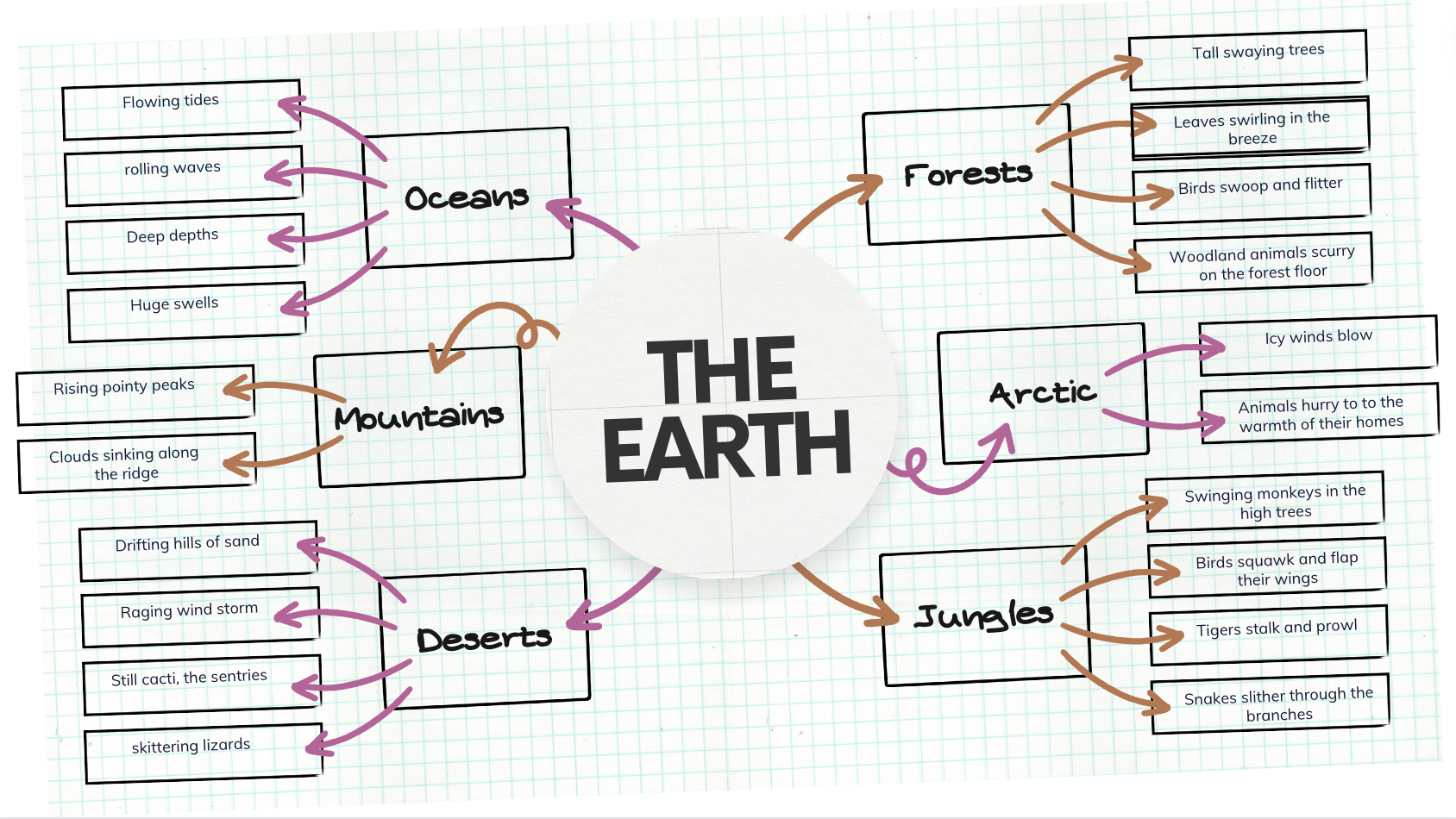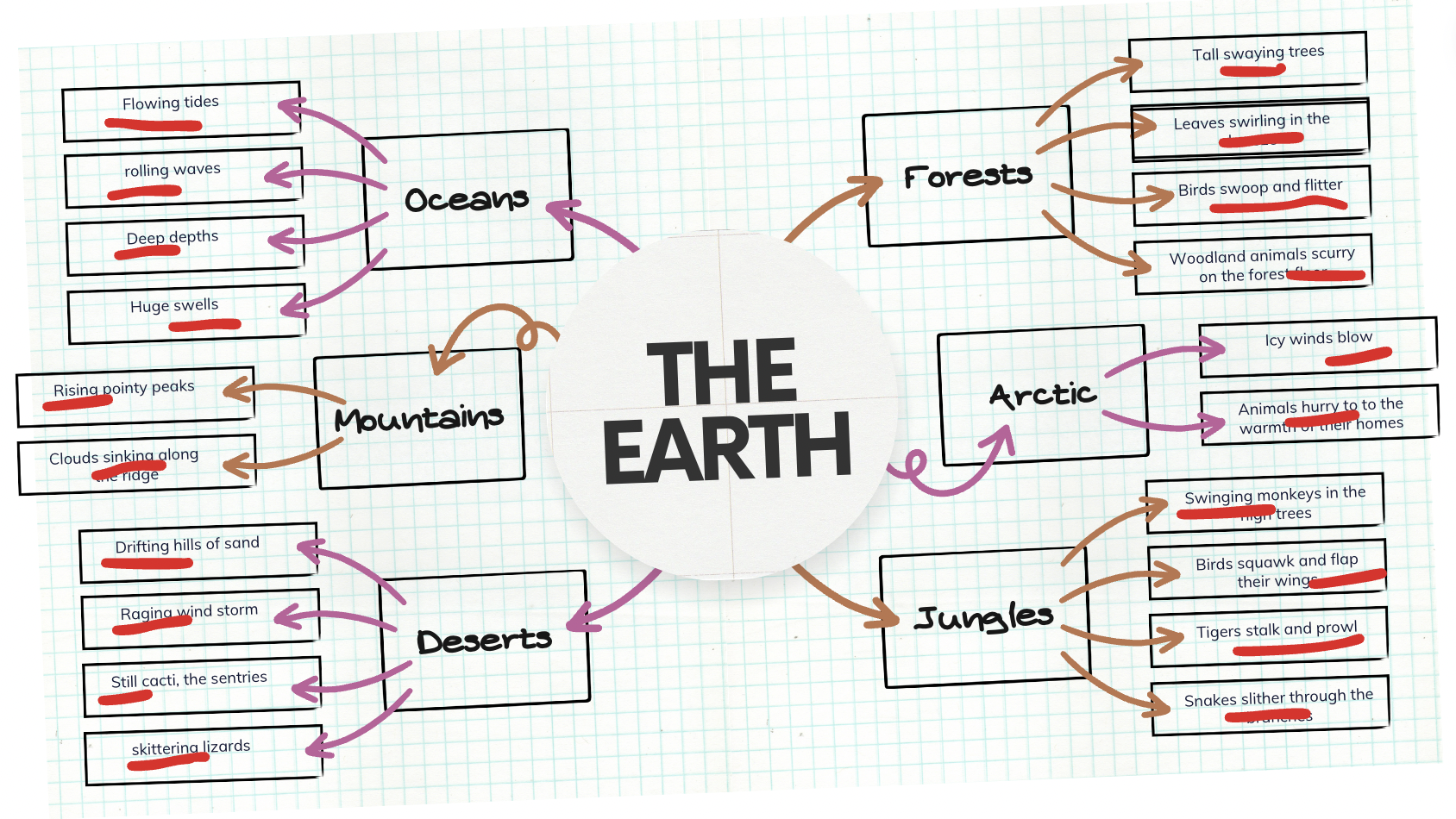
Earth Song
Earth Song: A Creative Movement Activity
Using Earth Song by Frank Ticheli, students are given elemental composition tools to craft unique movement accompaniments to a poignant and timely vocal piece with themes of peace and hope – just in time for Earth Day 2024!
Earth Song is a gorgeous vocal composition with origins in the work Sanctuary for wind ensemble. Diatonically living in F major and a strong form in 4/4 time, the lush and swelling 4-beat phrases elude traditional cadential harmony, and settle into an E phrygian resolution by the end. The atonality and undetermined harmonic destination create an incredible springboard for creative, unique movement compositions by students. The compositional process is prompted and guided by thinking maps designed to elicit biome characteristics from around the globe, pull out movement vocabulary for decision making, and utilizes visual organizers to aid in compositional brainstorming and refinement along the way.

Thinking maps and graphic organizers are a favorite way of mine to begin movement activities, because it naturally filters and focuses language prompts that evolve into the impetus of movement decisions.




From here, the class as a whole will split into small groups, each assigned to their own biome. They will transfer their biome and the movement words pulled out of the brainstorming session into a targeted organizer for their unique movement piece.

At this point, I expose them to the music we will be working with, Earth Song. I love to use the recording made by Virtual Choir HQ, featuring 167 singers hailing from 21 different professional choirs around the world.
I find it powerful to post the lyrics as we listen:
Sing, Be, Live, See.
This dark stormy hour,
The wind, it stirs.
The scorched earth
Cries out in vain:
O war and power,
You blind and blur,
The torn heart
Cries out in pain.
But music and singing
Have been my refuge,
And music and singing
Shall be my light.
A light of song
Shining Strong: Alleluia!
Through darkness, pain, and strife, I’ll
Sing, Be, Live, See…
Peace.
In a quick additional brainstorm, I ask them to describe the feelings, emotions, and impressions they get from listening to this piece. This will be crucial to leading them into creating movement pieces that “fit” with the recording of Earth Song that we will be using. For instance, if the Jungle group are planning on thrashing around like toucans and monkeys, this would help them adapt to interpretations that fit better with the mood of Earth Song.
Then, I post a collection of Movement Vocabulary words (using categories derived from Creative Dance by Anne Greene Gilbert) for them to use as they return to their groups’ Movement Plan.


With these guides and prompting vocabulary at their disposal, they are tasked with using the remaining fields of their plan to map out exactly how each word from their biome characteristics can translate into a movement representation. Plenty of time is given to experiment, test ideas, and refine.

As students develop three different gestures for their biome words, give them the additional task of creating transition movements to get from the end of one part and to the beginning of the next part.
- How would you travel to “reset” for the next part?
- How would you move to “stay in character” during the transition?
- How would you communicate without words to your group to move through each section and transition?

Now it is time to coach each composition to fit into the phrase lengths of Earth Song.
Start playing slow 4-beat phrases on a drum and ask the students to stretch and sustain each of the three sections of their movement piece across 4 beats, and then use the following 4 beats to transition or travel, and then begin the next section of their movement pieces over the next 4 beats, etc. The form will evolve into:

Plenty of time should be given for refinement and edit during the phase of the process.
“Finally, on a daily level, risk a slower pace in your own work with children, a pace that allows time to consider creative questions and their answers. Personal reflection and construction of knowledge takes more time than simply dictating knowledge.” – Peter Webster, “Thinking in Music Education, Encouraging the Inner Voice.”
Time must be allotted to allow students to feel, analyze, and constructively work through places that “feel weird” or “don’t fit” and to work toward the group consensus, and ultimately feel really good and confident executing their final version.

Now it is time to add Earth Song in. I like to let them just listen one more time, breathing with the 4 beat phrases, and following along on their group’s plan and with the roadmap. On a second pass through, we will practice grafting the movement onto the recording, and spend more time sharing out to the other groups.
As a final group version, I like to put the groups into canon, having one group begin, and introducing the following groups one at a time in offset intervals. The layers of movement and characteristic expression, unified by the breath of the 4 beat phrases is so dynamic and fascinating.
This activity can be incorporated into a larger collection of activities for a variety of performances. From humble building blocks of vocabulary, the results are a multidimensional expression of creativity, layered with a gorgeous choral piece singing for peace.
Project Details

Beginning with accessible and cross-disciplinary guides and organizers, this activity follows the concrete definable language associated with Earth’s biomes, and unlocks creative expressive movement in small group settings. The compositional process is guided but unbound, and the inspiration is rooted in emotional and deeply moving choral music.

4th graders will brainstorm, prioritize, and compose movement poetry and performance pieces, and be able to articulate their creative process.
- Fourth Grade, Standard 1. Expression of Music: Demonstrate practice and refinement processes to develop independent musicianship
- Fourth Grade, Standard 2. Creation of Music: Compose, improvise, and arrange sounds and musical ideas to communicate purposeful intent.
- Fourth Grade, Standard 3. Theory of Music: Identify and demonstrate complex form, meter, and timbre elements – Form: Aurally identify a variety of forms including recurring themes, interludes, canons and theme/variations.
- Fourth Grade, Standard 4. Aesthetic Valuation of Music: Evaluate and respond to music using criteria to make informed musical decisions.

- Use as a part in a greater showcase with Earth/environment/science/SEL/collaborative/peace themes
- As a gateway into larger movement or creative composition activities
- As an accompaniment to a story or piece of literature

Think of this activity as a beginning, with endless process variables and directions you could take. Some of the variations could include but are by no means limited to:
Poetry
Thinking maps and graphic organizers are a readily accessible entry point and guide through this activity, but beginning with poetry is just as effective. Consider collecting haikus, cinquain, or tetractys poems that are short, focused, and unfold musically, and have the students identify movement words in their poems and take up the process from that point of inspiration. Or, have students compose their own earth-themed poetry and pull out the movement prompts from their own creations.
Music
Do you have an arrangement that would accompany this activity? Grafting creative movement onto student arrangements and compositions can be done following the outlined process, by breaking down the components of a movement piece and its transitions, and fitting them into the phrase lengths of any piece of music.
Visual Additions
Working with Light
- Putting the movers behind a shadow screen unleashes incredible visual dynamics to an activity like this, and would no doubt spark a rabbit hole of compositional ideas in your students.
- Projecting light down onto the performers, perhaps a different hue for each represented biome would add to the distinctness and qualities of each group’s impetus for compositionAdding Movement Props
- Adding scarves, ribbons, stretchy bands, or lights like this (a special thanks to Dave Thaxton for the discovery of these bad boys) would be an engaging layer to add to each movement piece
- placing groups on tiered levels in a performance would add fascinating depth to the visual presentation
- Adding a projection of scenes of nature or even the Earth Song performance would elicit the theme and add an interesting accompaniment
Assessment
Evaluating the efficacy of this type of activity can be tricky, subjective, and unclear. In activities that are creative and compositional in nature, with unclear and open-ended outcomes, I like to utilize an area of evaluation that is incredibly valuable: assessment as learning, ie: assessment done by the student, as the activity is evolving. An idea introduced to me by the incredible Victoria Redfern-Cave at AOSA National Conference 2017, this is clearly and easily achieved by leading the students through self-created rubrics that define and track what success looks like in a compositional activity. This naturally helps eliminate moments where students are asking questions such as, “Is this what you want?” or “I don’t get it.”
Student-Created Rubrics as a a guide through an abstract activity, and checklist for success:
- Create categories that can be assessed by someone watching a performance of this activity. These should be categories where the students have received actual instruction, such as how each section of the movement is developed and composed, what transitions look like and how are they considered successful, and how we work with the members of our groups.
- Create levels of possibility and valuation that are age appropriate. I find this often boils down to “Did you do this thing? Check yes or no”
- Fill-in the blanks with descriptive language.
An example of a rubric made in a whole-class discussion, identifying what effective participation looks like and defining success could look like this:

See all posts by Justine Marie Sullivan
1 Comments
Leave a Comment
Sign up for latest Orff Tips, Lesson Plans and Advocacy Tools

Empower your students to create their own music in this free 3-day challenge with Roger Sams. (Lessons delivered via email)

Learn about the legendary factory that started it all and why so many teachers like you love our instruments.

Hi, I’m dying to try this! It is so much different than the songs, dances, and games that we usually do and I think I can “sell” it to my students if I’m super excited (all set there!) and really prepared. I understand the process and the different ways to play with it as a “performance” . I am not sure how the movement sequences they create fit onto/with the music itself. Could they use a certain lyric or phrase as a cue? Do you by any chance have a video I could watch to get a better understanding?